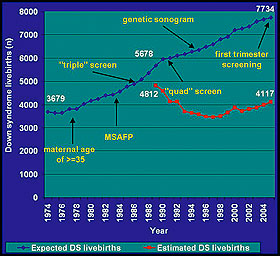  |
| HOME | THIS ISSUE | CALENDAR | GRANTS | BACK ISSUES | < BACK | NEXT > |
Prenatal testing for Down syndrome raises ethical concerns by Chris DeFrancesco - June 8, 2009 |
||||
| Scientific advances over the last three decades have introduced several methods of screening and diagnosing Down syndrome during pregnancy. And as the number of prenatal screening options grows, so do related ethical concerns. The newest chapter is what’s known as noninvasive prenatal diagnosis. At least one biotech company purportedly is on the verge of offering a way to detect the chromosome abnormality associated with Down syndrome, trisomy 21, based on a blood test that detects small quantities of the baby’s genetic material present in the mother’s blood. “This new method has not gone through the battery of clinical trials, quality assurance, and other steps to prove and ensure its accuracy, so the first question is, is this new method as reliable as claimed?” says Professor Peter Benn, director of the UConn Health Center’s Diagnostic Human Genetics Laboratories and co-author of a commentary published in the May 27 Journal of the American Medical Association. “Let’s say it is as accurate as amniocentesis, the invasive testing that is currently used to diagnose Down Syndrome. Certainly that offers advantages, but we have to consider how this testing might best be offered to women. Benn notes that currently, women usually only receive detailed genetic counseling after they have undergone screening tests that identify them as being at high risk. All women considering the new testing would have to be counseled, but there are not sufficient numbers of genetic counselors available for this purpose, he says. Co-author Audrey Chapman, a professor in the Division of Medical Humanities, Health Law and Ethics at the Health Center, says, “The new testing introduces a real need for standards of care and professional guidelines, because patients cannot be expected to completely understand their full clinical implications. Otherwise, physicians would also feel obligated to provide both noninvasive diagnosis and current standards of care to protect against malpractice, which would mitigate the full benefits of the noninvasive prenatal diagnosis.” The abortion debate is unavoidable. The earlier in a pregnancy Down syndrome can be definitively detected, the easier it is to terminate the pregnancy. And with the potential for a significantly reduced prevalence of Down syndrome comes the possible unintended consequence of negative public perception. If society becomes less accepting of the idea of carrying out an affected pregnancy, it “could diminish understanding and support for affected individuals and their families and increase the stigma associated with having a genetic disorder,” the authors write.
A Health Center study presented by Dr. James Egan, chairman of the Department of Obstetrics and Gynecology, suggests that the number of Down syndrome live births in the United States has been fairly constant over the past 30 years. The study also estimates that Down syndrome live births would have nearly doubled over that same time period in the absence of prenatal screening and pregnancy terminations. “Our data indicate that as the availability and reliability of Down syndrome screening methods improved, a smaller percentage of affected pregnancies were continuing,” Egan says. “The percentage decreased from 1989 to 1998 and then leveled off in the late 90s, at around 50 percent of the Down syndrome live births expected. One possible explanation for this plateau in live births is patient ambivalence about Down syndrome screening.” One in every 733 babies is born with Down syndrome, the most commonly occurring chromosome condition, according to the National Down Syndrome Society. In the future, noninvasive prenatal diagnosis will be able to identify many genetic disorders, predispositions, and traits. Benn and Chapman acknowledge that noninvasive prenatal diagnosis is an idea with potential clinical value, but that the ethical considerations cannot be taken lightly. “Careful thought and debate on how to shape an era in which a newborn’s future growth and potential is no longer entirely a source of speculation and wonder are essential,” they write. Benn and Chapman’s commentary is available through the Journal of the American Medical Association web site. |
| ADVANCE HOME UCONN HOME |

